Effective recovery modalities are crucial for optimizing athlete health and performance. Key approaches include active recovery, cryotherapy, compression therapy, and proper nutrition. Psychological factors also influence recovery outcomes, while emerging trends focus on personalized strategies and technology integration. Addressing challenges in implementation can enhance the effectiveness of these recovery techniques.
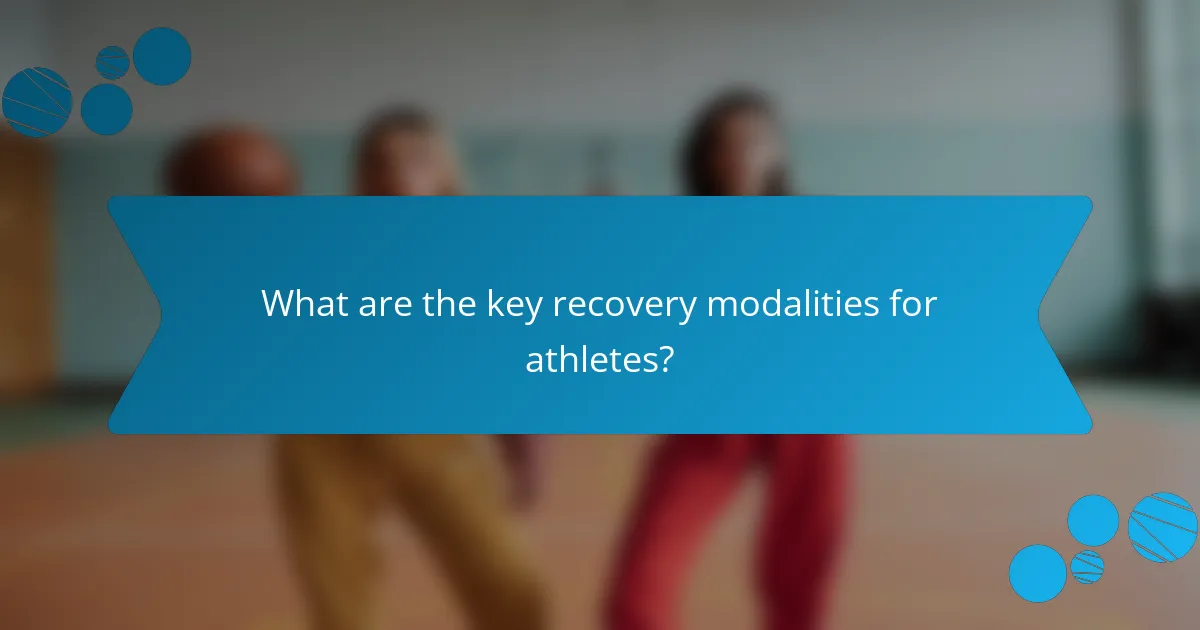
What are the key recovery modalities for athletes?
Key recovery modalities for athletes include active recovery, cryotherapy, compression therapy, and nutrition. Each modality plays a significant role in enhancing athlete health and performance.
Active recovery involves low-intensity exercises that promote blood circulation and reduce muscle soreness. Cryotherapy uses cold temperatures to decrease inflammation and speed up recovery. Compression therapy enhances blood flow and reduces swelling through the application of pressure. Proper nutrition provides essential nutrients for muscle repair and energy replenishment.
Incorporating these modalities can significantly improve an athlete’s recovery process, leading to better performance outcomes.
How do recovery modalities impact athletic performance?
Recovery modalities significantly enhance athletic performance by improving physical recovery and reducing injury risk. Techniques such as foam rolling, cryotherapy, and active recovery promote muscle repair and circulation. Research indicates that athletes utilizing these methods experience lower levels of muscle soreness and faster recovery times. For example, athletes who engage in regular active recovery sessions report a 30% decrease in muscle fatigue. Incorporating these modalities can lead to improved training outcomes and overall performance.
Which recovery modalities are most popular among professional athletes?
Professional athletes commonly use modalities such as cryotherapy, massage therapy, hydrotherapy, and active recovery. These methods enhance recovery and improve performance.
Cryotherapy involves exposure to extremely cold temperatures, reducing inflammation and pain. Massage therapy promotes blood flow and muscle relaxation, aiding recovery. Hydrotherapy utilizes water for therapeutic benefits, including muscle relaxation and pain relief. Active recovery, such as light exercises, helps maintain blood circulation without straining the body.
Research indicates that incorporating these modalities can lead to quicker recovery times and improved overall athletic performance.
What role does active recovery play in athlete health?
Active recovery significantly enhances athlete health by promoting circulation, reducing muscle soreness, and facilitating faster recovery. Engaging in low-intensity activities helps maintain blood flow, which delivers essential nutrients to muscles. This process accelerates the removal of metabolic waste, improving overall recovery times. Additionally, active recovery can improve mental well-being, fostering a positive mindset during training and competition. Regular implementation of active recovery strategies can lead to better performance outcomes and reduced injury risk.
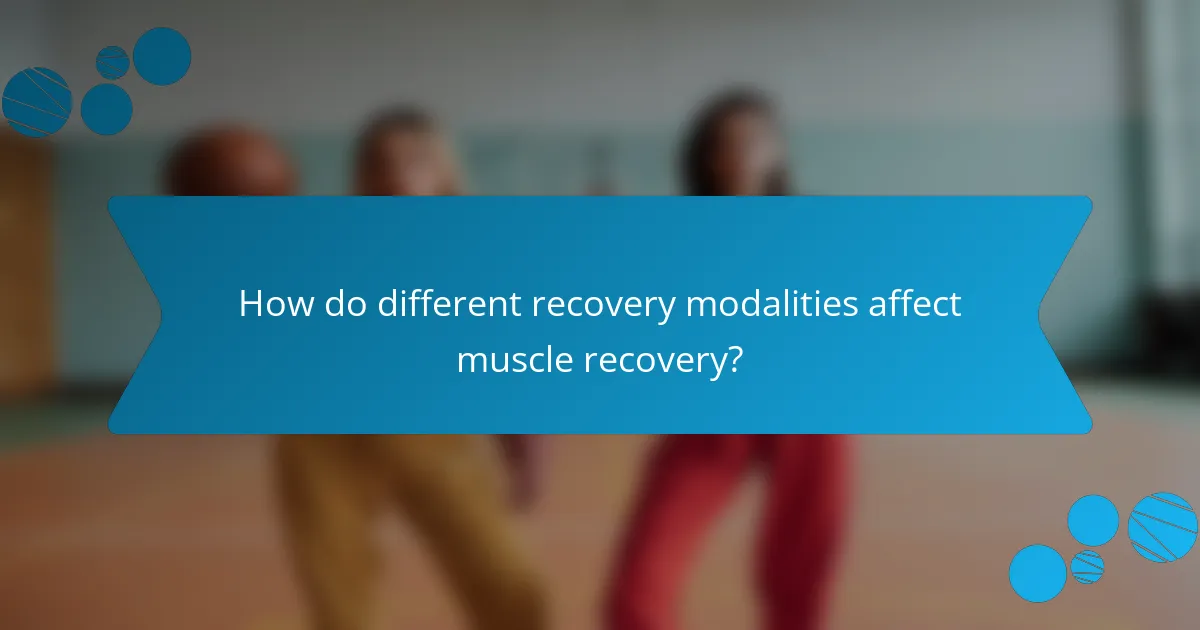
How do different recovery modalities affect muscle recovery?
Different recovery modalities significantly enhance muscle recovery by reducing soreness and improving performance. Techniques such as active recovery, cryotherapy, and compression therapy each offer unique benefits.
Active recovery involves low-intensity exercise that promotes blood flow, aiding nutrient delivery to muscles. Cryotherapy reduces inflammation and pain, helping athletes recover faster after intense workouts. Compression therapy enhances circulation, which can decrease muscle soreness and speed up recovery time.
Utilizing a combination of these modalities can lead to optimal recovery outcomes, enabling athletes to maintain peak performance levels.
What are the physiological benefits of cryotherapy?
Cryotherapy offers several physiological benefits that enhance athlete recovery and performance. It reduces inflammation, alleviates muscle soreness, and boosts recovery speed. Additionally, cryotherapy can improve circulation, enhance metabolic rate, and increase pain tolerance. These effects contribute to overall athletic performance by facilitating quicker recovery between training sessions and competitions.
How does massage therapy enhance recovery?
Massage therapy enhances recovery by promoting circulation, reducing muscle soreness, and improving flexibility. This modality aids in the removal of metabolic waste, thereby accelerating healing. Research indicates that regular massage can decrease recovery time by up to 30%. Additionally, massage therapy can alleviate stress and anxiety, which are detrimental to athletic performance. The unique attribute of massage therapy lies in its ability to tailor techniques to individual needs, fostering a personalized recovery experience.
What is the impact of hydrotherapy on muscle soreness?
Hydrotherapy significantly reduces muscle soreness by enhancing blood circulation and promoting relaxation. This recovery modality aids in flushing out metabolic waste and alleviating inflammation. Studies indicate that immersion in warm water can lead to a 20% reduction in muscle soreness within 24 hours post-exercise. Additionally, the buoyancy effect reduces joint stress, allowing for more effective recovery sessions.
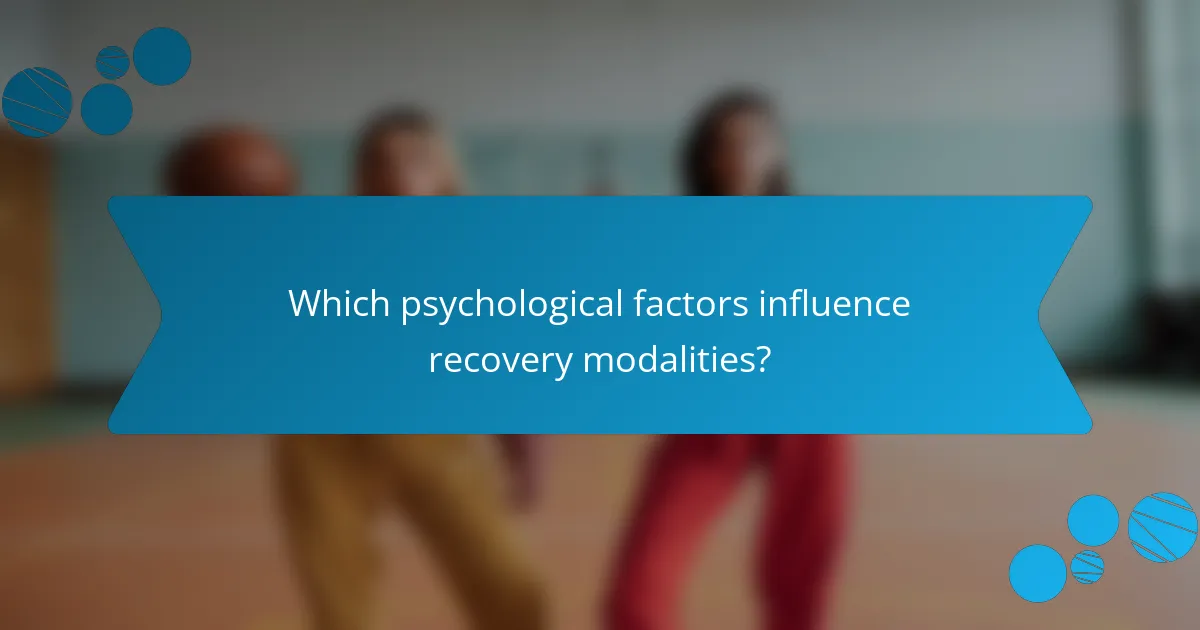
Which psychological factors influence recovery modalities?
Psychological factors significantly influence recovery modalities for athletes. Mental resilience, motivation, and stress management directly affect recovery outcomes. For example, athletes with a positive mindset often experience faster recovery rates. Additionally, social support enhances emotional well-being, leading to improved adherence to recovery protocols. Understanding these psychological elements can optimize recovery strategies and enhance overall performance.
How do mental health and recovery practices intersect for athletes?
Mental health and recovery practices intersect significantly for athletes, enhancing their overall well-being and performance. Effective recovery modalities, such as mindfulness and physical therapies, help athletes manage stress and prevent burnout.
Research indicates that mental health support can improve recovery outcomes, leading to better performance metrics. For instance, athletes who engage in mental recovery strategies report higher levels of focus and reduced anxiety during competitions.
Additionally, integrating mental health practices into recovery routines fosters resilience, enabling athletes to cope with physical and emotional challenges. This holistic approach promotes a balanced mindset, essential for sustained athletic success.
In summary, the intersection of mental health and recovery practices is crucial for optimizing athlete performance and well-being.
What role does mindfulness play in recovery?
Mindfulness significantly enhances recovery by promoting mental clarity and emotional stability. It helps athletes manage stress, reduce anxiety, and improve focus, leading to better overall performance. Practicing mindfulness techniques, such as meditation or breathing exercises, can facilitate faster physical recovery by lowering cortisol levels and enhancing sleep quality. Additionally, mindfulness fosters a positive mindset, which is crucial for overcoming setbacks and maintaining motivation during recovery.

What are the emerging trends in recovery modalities for 2025?
Emerging trends in recovery modalities for 2025 emphasize personalized approaches and technology integration. Athletes will increasingly utilize data analytics for tailored recovery plans. Wearable devices will monitor physiological responses, enhancing recovery efficiency. Virtual reality will offer immersive rehabilitation experiences, addressing mental and physical recovery needs. Furthermore, holistic practices like mindfulness and nutrition optimization will gain traction, supporting overall athlete well-being.
How is technology shaping recovery practices in sports?
Technology significantly enhances recovery practices in sports, improving athlete health and performance. Advanced tools like cryotherapy, compression therapy, and wearable devices provide precise data on recovery metrics. These innovations help athletes optimize their recovery strategies, leading to reduced injury risk and improved performance outcomes. For instance, wearable technology tracks physiological responses, allowing for tailored recovery protocols. Additionally, virtual reality and telehealth services facilitate remote monitoring and personalized recovery plans. As a result, technology transforms recovery into a data-driven process, ensuring athletes can perform at their best.
What innovative recovery tools are gaining traction among athletes?
Innovative recovery tools such as cryotherapy, infrared saunas, and percussion therapy are gaining traction among athletes. These modalities enhance recovery by reducing inflammation, improving circulation, and alleviating muscle soreness.
Cryotherapy involves exposing the body to extremely cold temperatures, which can decrease muscle damage and accelerate healing. Infrared saunas utilize heat to promote detoxification and relaxation, while percussion therapy devices, like massage guns, provide targeted relief to sore muscles.
Recent studies indicate that athletes using these recovery tools report improved performance and reduced recovery times. As more athletes adopt these methods, their effectiveness continues to be validated through ongoing research.
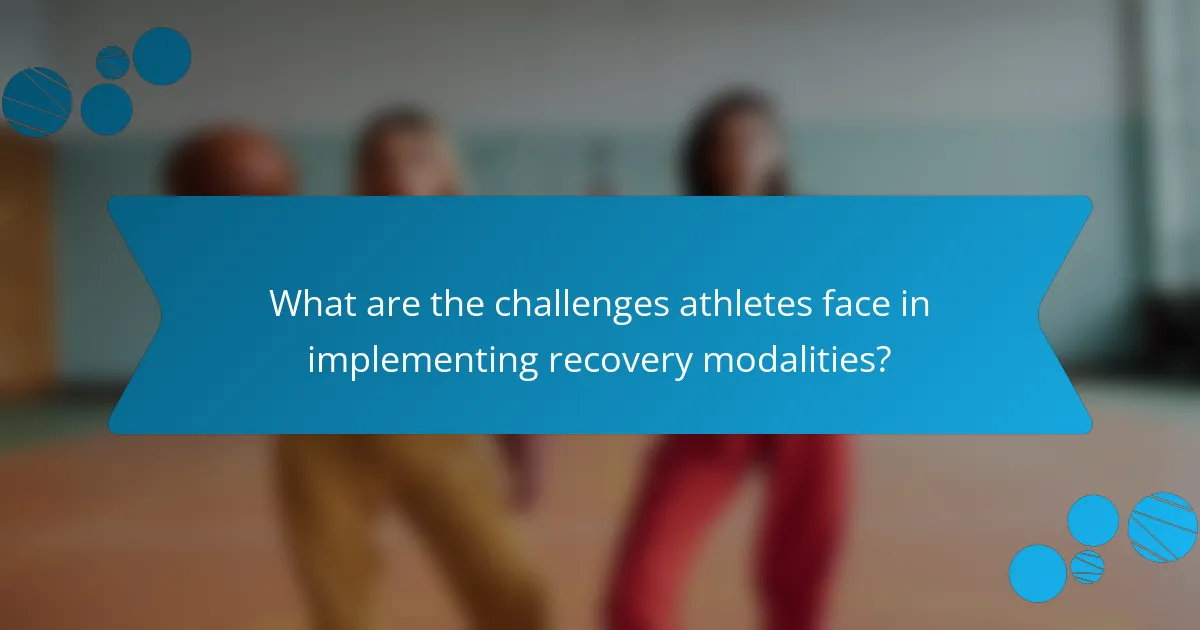
What are the challenges athletes face in implementing recovery modalities?
Athletes face challenges in implementing recovery modalities due to time constraints, access to resources, and varying effectiveness. Limited recovery time often hampers athletes’ ability to engage in optimal recovery practices. Additionally, not all modalities are equally accessible, creating disparities. Individual responses to recovery methods can vary, complicating the selection of effective strategies.
How do time constraints affect recovery practices?
Time constraints negatively impact recovery practices by limiting the time available for essential recovery modalities. Athletes may rush recovery techniques, leading to inadequate rest and increased injury risk. Research shows that optimal recovery duration enhances muscle repair and performance, while insufficient recovery can hinder athletic progress. Prioritizing effective recovery within limited time frames is crucial for maintaining athlete health and performance.
What common misconceptions exist about recovery modalities?
Common misconceptions about recovery modalities include the belief that all methods are equally effective, that they can replace proper rest, and that more expensive treatments guarantee better results. Many athletes assume that passive modalities alone will suffice for recovery, neglecting the importance of active recovery strategies. Additionally, there is a misconception that recovery modalities can prevent all injuries, while their primary role is to enhance recovery and performance.
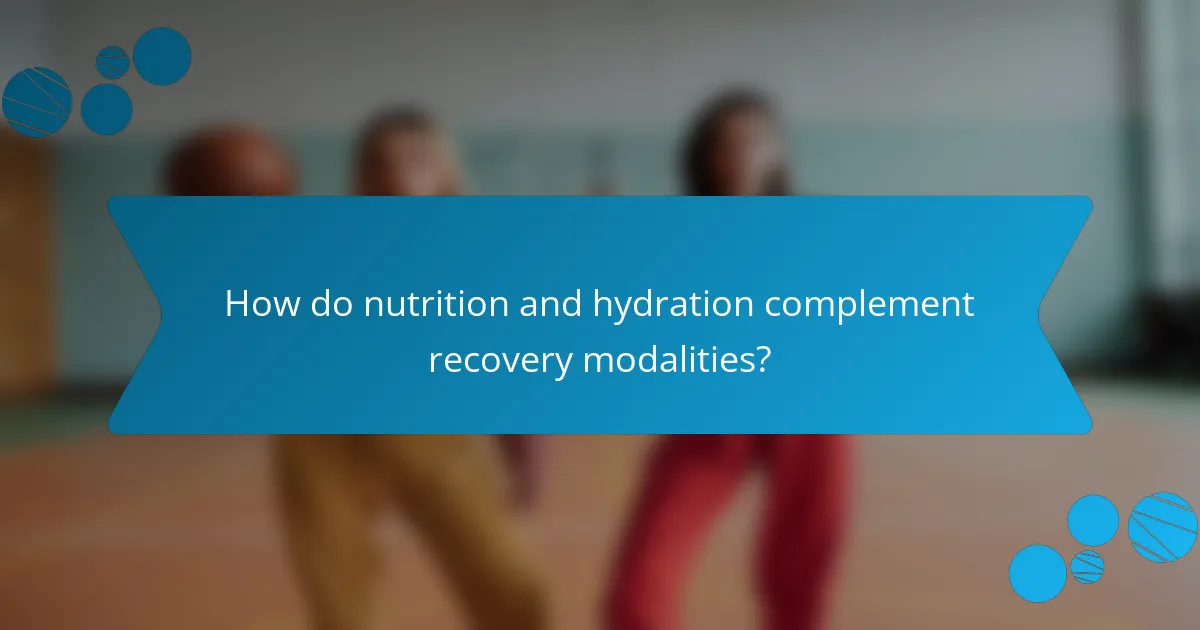
How do nutrition and hydration complement recovery modalities?
Nutrition and hydration significantly enhance recovery modalities by providing essential nutrients and fluids that facilitate muscle repair and overall recovery. Adequate protein intake supports muscle synthesis, while carbohydrates replenish glycogen stores. Hydration maintains performance and aids in nutrient transport. Together, they optimize the effectiveness of recovery strategies like rest, physical therapy, and active recovery. Proper nutrition and hydration can reduce recovery time, improve performance outcomes, and help prevent injuries, making them vital components of an athlete’s regimen.
Which nutrients are essential for optimal recovery?
Essential nutrients for optimal recovery include proteins, carbohydrates, fats, vitamins, and minerals. Proteins aid muscle repair, while carbohydrates replenish glycogen stores. Healthy fats support inflammation reduction. Vitamins and minerals play critical roles in overall recovery processes. For example, vitamin C enhances collagen synthesis, crucial for tissue repair.
How does hydration status influence recovery outcomes?
Hydration status significantly influences recovery outcomes by enhancing muscle repair and reducing fatigue. Adequate fluid intake supports nutrient transport and waste removal, crucial for optimal recovery. Studies show that even mild dehydration can impair recovery, leading to longer downtime and decreased performance. For athletes, maintaining hydration is essential for effective recovery and overall health.
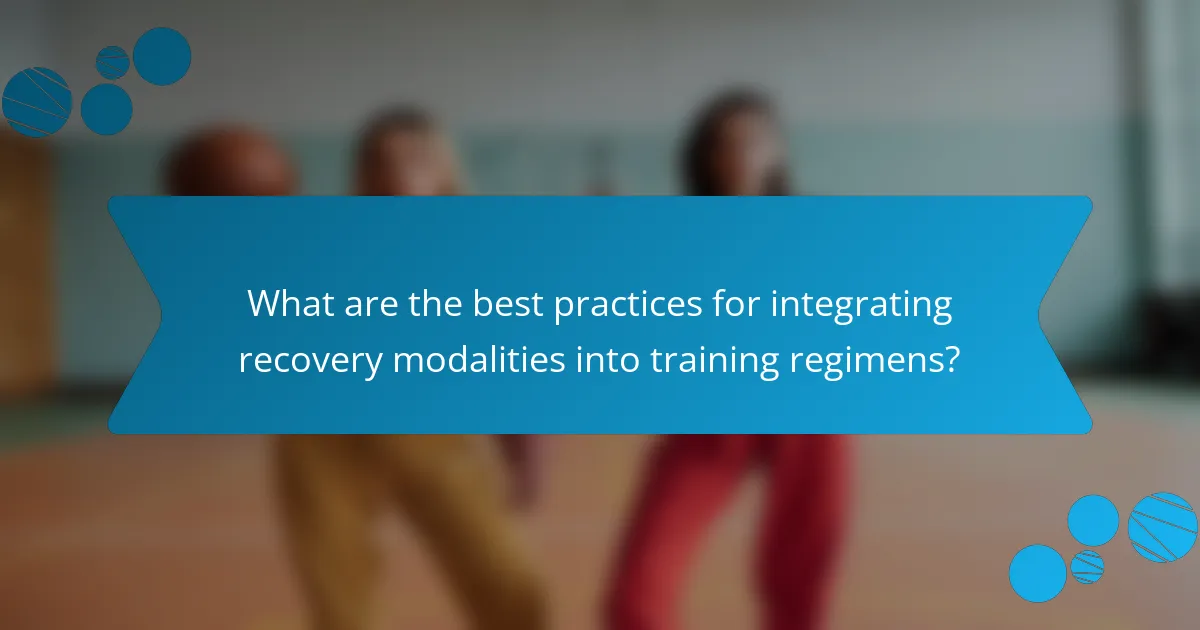
What are the best practices for integrating recovery modalities into training regimens?
Integrating recovery modalities into training regimens enhances athlete health and performance. Prioritize modalities like active recovery, hydration, nutrition, and sleep. Employ techniques such as foam rolling, stretching, and cold therapy for muscle recovery. Schedule recovery days to prevent overtraining and promote adaptation. Monitor recovery metrics to tailor approaches for individual needs.
How can athletes create a personalized recovery plan?
Athletes can create a personalized recovery plan by assessing their individual needs and goals. Start by identifying specific recovery modalities, such as active recovery, nutrition, hydration, and sleep quality. Incorporate techniques like foam rolling, stretching, or massage based on personal preferences and recovery response. Monitor progress and adjust the plan as needed to optimize health and performance. Regularly review the effectiveness of chosen modalities to ensure they align with training demands and recovery outcomes.
What common mistakes should athletes avoid in their recovery strategies?
Athletes should avoid common mistakes in recovery strategies to enhance health and performance. Key pitfalls include neglecting hydration, skipping rest days, relying solely on passive recovery, and ignoring nutrition.
Hydration is crucial; dehydration can impair recovery and performance. Rest days allow the body to repair and adapt, while overtraining can lead to injuries. Passive recovery methods, like massage, should complement active recovery techniques, such as light exercise or mobility work. Lastly, nutrition plays a vital role; inadequate intake of essential nutrients can hinder the recovery process.
What expert tips can enhance the effectiveness of recovery modalities?
Incorporating expert tips can significantly enhance recovery modalities for athletes. Prioritize individualized recovery plans based on specific needs and goals.
Integrate modalities such as active recovery, hydration, and nutrition to optimize performance. Utilize tools like foam rollers and compression garments to aid muscle recovery. Monitor recovery metrics, including sleep quality and heart rate variability, to adjust strategies effectively. Lastly, encourage mental recovery techniques, such as mindfulness and visualization, to support overall well-being.